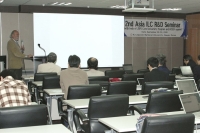 |
 |
|||||||||||||
|
|||||||||||||
|
|||||||||||||
|
From 29 to 30 September, the second Asia ILC R&D Seminar was held at Kyungpook National University (KNU) in Korea with help from the Japan Society for the Promotion of Science Core University Program and the Korea Science and Engineering Foundation. This workshop aimed to review the progress of R&D for the ILC accelerator in Asia region, and to promote regional and inter-regional collaborations on the accelerator and active participations from individual countries to ILC, focusing on the installation schedule and preparation for commissioning. The presentation on the status of Chinese ILC R&D was given by Jie Gao from the Institute of High Energy Physics, Chinese Academy of Sciences (IHEP). In his presentation, among other topics, such as ILC damping ring design (Modified FODO lattice), ILC damping ring fast kicker R&D plan, ATF2 optics optimization work in collaboration with LAL (Orsay), and positron source studies in collaboration with KEK, he reported Chinese engagement on new Low Loss-type 9 cell cavities R&D. The aim of this R&D is to learn and master 1.3-gigahertz superconducting accelerator technology, acquiring the experiences in design, construction, testing and operation of 9-cell cavities, also in couplers, cryostats and low-level radio frequency technology. “Now IHEP has formed a project group of 1.3-giga hertz superconducting test unit, headed by myself,” said Gao. Based on the related R&D work on 1.3-gigahertz single-cell large-grain superconducting cavities, coupler and cryomodule design in the past few years, the first bare tube of a 9-cell large grain cavity is under fabrication, and the physical design of the cryomodule is almost finished. “The first bare cavity and the first cavity with couplers will be low-loss-type, the same as our single superconducting cavity shape still using the Chinese "Ning Xia" large-grain material. In the future we might try also TESLA-type 9-cell cavities”, he said. If the R&D makes good progress, this cavity might be used for the Global Design Effort "Global S1 project" (more). “The second Asia ILC Seminar could provide the opportunities to promote the Asia regional collaborations to ILC and review the progresses of the Asia regional accelerator related R&D activities,” said Eun-San Kim from KNU who was one of the organisers. Following the second Asia ILC R&D Seminar, the ATF2 project meeting was also held, where attendants reported on the status of ATF2 project and discussed the detailed plans for 2008 and the future of ATF2 project. The ATF2 project meeting is normally held twice a year, but this one was held additional to the regular meetings in preparation for ATF2 commissioning. The status of every component and detailed commissioning plan with strategy and schedules was discussed, with the Asian participants in Korea and colleagues from Americas and Europe through web meeting system. The commissioning is expected in the beginning of November. -- Rika Takahashi |
|||||||||||||
| © International Linear Collider |
